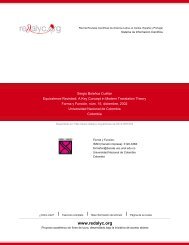Portraits of the spiritual Seeing in Mark's Gospel. Origen ... - Redalyc
Portraits of the spiritual Seeing in Mark's Gospel. Origen ... - Redalyc
Portraits of the spiritual Seeing in Mark's Gospel. Origen ... - Redalyc
You also want an ePaper? Increase the reach of your titles
YUMPU automatically turns print PDFs into web optimized ePapers that Google loves.
Jesus and <strong>the</strong> Demons:...<br />
337<br />
Abstract: In Mark’s narrative, it is possible to identify three important verbs that<br />
signify visual perception: Horáō, Blépō, and Theōréō with <strong>the</strong>ir respective nuances.<br />
In addition to <strong>the</strong>ir lexicographic def<strong>in</strong>itions, <strong>the</strong>y acquire a very unique semantic<br />
dimension depend<strong>in</strong>g on <strong>the</strong>ir subject, object, and narrative context. These syntactic<br />
and narrative determ<strong>in</strong>ations <strong>of</strong> <strong>the</strong> analysis applied to selected texts allow <strong>the</strong><br />
reader to discover a meta-physical portrait <strong>of</strong> see<strong>in</strong>g <strong>in</strong> Jesus and <strong>the</strong> demons. This<br />
means that <strong>the</strong>ir see<strong>in</strong>g goes beyond <strong>the</strong> physical limits <strong>of</strong> <strong>the</strong> corporeal perception,<br />
be<strong>in</strong>g able to perceive <strong>the</strong> supernatural dimension immersed <strong>in</strong> <strong>the</strong> circumstantial<br />
events. This read<strong>in</strong>g founds its hermeneutic ground <strong>in</strong> <strong>the</strong> notion <strong>of</strong> <strong>the</strong> soul’ senses<br />
developed by <strong>Origen</strong> which found later on its development <strong>in</strong> <strong>the</strong> <strong>the</strong>ological<br />
thoughts <strong>of</strong> Bonaventure, and its practical and <strong>spiritual</strong> application <strong>in</strong> Ignatius <strong>of</strong><br />
Loyola’s <strong>spiritual</strong> exercise. This hermeneutic key applied to <strong>the</strong> Markan pericopes<br />
through <strong>the</strong> narrative and semantic approach helps <strong>the</strong> reader to discover <strong>the</strong><br />
<strong>spiritual</strong> dimension <strong>of</strong> <strong>the</strong> perception <strong>of</strong> Jesus and <strong>the</strong> demons, and <strong>the</strong>ir semantic<br />
implications <strong>in</strong> <strong>the</strong> kerygmatic narrative addressed to <strong>the</strong> community implied as <strong>the</strong><br />
receptor <strong>of</strong> <strong>the</strong> markan message.<br />
Keywords: Horáō, Blépō, Theōréō, to see, to observe, to contemplate, Jesus, Demons,<br />
physical, meta-physical.<br />
Resumen: En la narrativa del evangelio de Marcos es posible identificar tres verbos<br />
fundamentales que significan percepción visual: Horáō, Blépō y Theōréō. Estos<br />
engloban diversos niveles de significación que necesitan la ayuda del léxico especializado;<br />
pero esto no es suficiente para establecer otras dimensiones semánticas<br />
que se adquieren dependiendo del sujeto, objeto y contextos en los cuales los vocablos<br />
son empleados. El lector puede descubrir a través del uso del vocabulario y<br />
del método semántico-narrativo la dimensión del «ver» e<strong>spiritual</strong> como uno de los<br />
sentidos del alma especialmente caracterizado en el evangelio de Marcos. Este tipo<br />
de lectura ya encuentra su fundamento hermenéutico en los escritos de Orígenes<br />
que tratan sobre los sentidos e<strong>spiritual</strong>es del alma que permiten la percepción de la<br />
acción div<strong>in</strong>a escondida en la humanidad cont<strong>in</strong>gente. Tal noción es desarrollada<br />
de manera más sistemática en las reflexiones teológicas de Buenaventura, que luego<br />
se manifestarán en manera práctica a nivel e<strong>spiritual</strong> en Ignacio de Loyola. Este<br />
fundamento hermenéutico puede ser aplicado a los episodios de Marcos, ayudando<br />
al lector a percibir que los retratos narrativos del «ver» de Jesús y los demonios<br />
adquiere una dimensión metafísica, ya que ellos perciben la realidad div<strong>in</strong>a-e<strong>spiritual</strong><br />
escondida en la apariencia circunstancial que escapa a la visión física.<br />
Palabras clave: Horáō, Blépō, Theōréō, ver, observar, contemplar, Jesús, demonios,<br />
físico, metafísico.
















